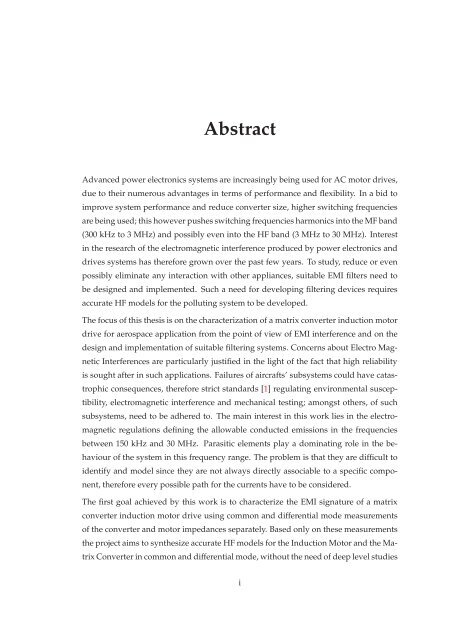PDF (Thesis) - Nottingham eTheses - University of Nottingham
PDF (Thesis) - Nottingham eTheses - University of Nottingham
PDF (Thesis) - Nottingham eTheses - University of Nottingham
Create successful ePaper yourself
Turn your PDF publications into a flip-book with our unique Google optimized e-Paper software.
Abstract<br />
Advanced power electronics systems are increasingly being used for AC motor drives,<br />
due to their numerous advantages in terms <strong>of</strong> performance and flexibility. In a bid to<br />
improve system performance and reduce converter size, higher switching frequencies<br />
are being used; this however pushes switching frequencies harmonics into the MF band<br />
(300 kHz to 3 MHz) and possibly even into the HF band (3 MHz to 30 MHz). Interest<br />
in the research <strong>of</strong> the electromagnetic interference produced by power electronics and<br />
drives systems has therefore grown over the past few years. To study, reduce or even<br />
possibly eliminate any interaction with other appliances, suitable EMI filters need to<br />
be designed and implemented. Such a need for developing filtering devices requires<br />
accurate HF models for the polluting system to be developed.<br />
The focus <strong>of</strong> this thesis is on the characterization <strong>of</strong> a matrix converter induction motor<br />
drive for aerospace application from the point <strong>of</strong> view <strong>of</strong> EMI interference and on the<br />
design and implementation <strong>of</strong> suitable filtering systems. Concerns about Electro Mag-<br />
netic Interferences are particularly justified in the light <strong>of</strong> the fact that high reliability<br />
is sought after in such applications. Failures <strong>of</strong> aircrafts’ subsystems could have catas-<br />
trophic consequences, therefore strict standards [1] regulating environmental suscep-<br />
tibility, electromagnetic interference and mechanical testing; amongst others, <strong>of</strong> such<br />
subsystems, need to be adhered to. The main interest in this work lies in the electro-<br />
magnetic regulations defining the allowable conducted emissions in the frequencies<br />
between 150 kHz and 30 MHz. Parasitic elements play a dominating role in the be-<br />
haviour <strong>of</strong> the system in this frequency range. The problem is that they are difficult to<br />
identify and model since they are not always directly associable to a specific compo-<br />
nent, therefore every possible path for the currents have to be considered.<br />
The first goal achieved by this work is to characterize the EMI signature <strong>of</strong> a matrix<br />
converter induction motor drive using common and differential mode measurements<br />
<strong>of</strong> the converter and motor impedances separately. Based only on these measurements<br />
the project aims to synthesize accurate HF models for the Induction Motor and the Ma-<br />
trix Converter in common and differential mode, without the need <strong>of</strong> deep level studies<br />
i
















